Testing the Waters with Davis
Alabama pro tries to get a feel for the postspawn status on Kentucky Lake
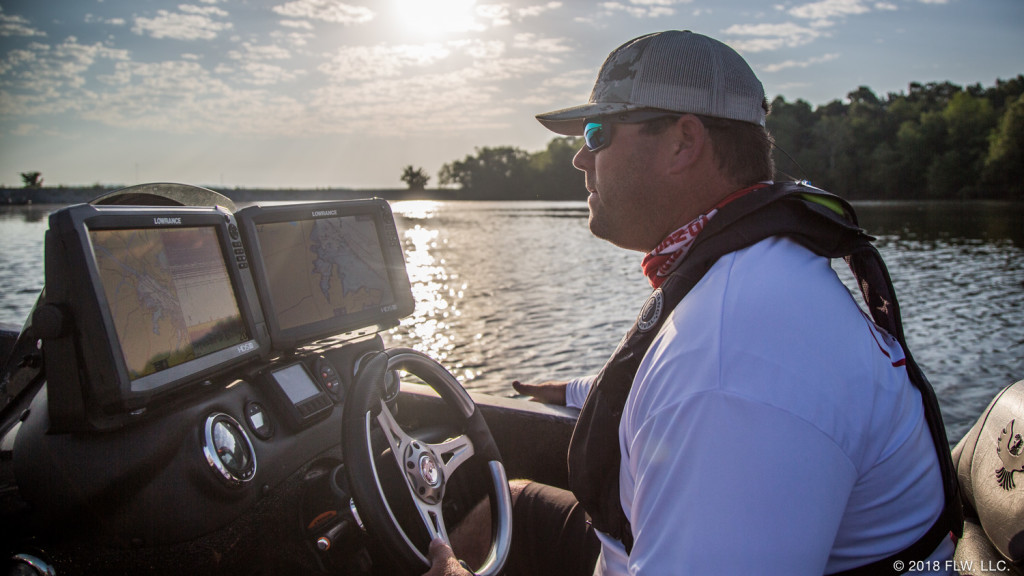
Some people make the mistake of thinking that tournament practice is always about figuring out where the fish are and what they’re doing. In most cases – and especially in the spring – the real goal is predicting where the fish are going to be and what they’re going to be doing a few days later. A few days in the life of a bass, particularly during the transitional postspawn period on the Tennessee River, is an eon. Everything can change.
Clent Davis understands this quite well, so he’s not overly concerned about getting a late start on the first day of practice for the FLW Tour event presented by Costa Sunglasses on Kentucky Lake. It’s 6:45 a.m. when he pulls into the ramp at Kentucky Dam State Park and unhooks the straps on his boat to get the search started for stop No. 6 of the 2018 season.
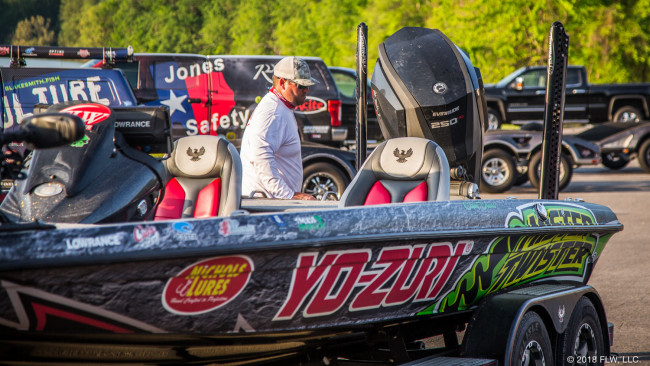
Davis’ original plan was to put in at daybreak about an hour earlier and chase a shad spawn bite before stowing the rods and sitting down in front of dual Lowrance units to begin scanning Kentucky Lake’s ledges for the first postspawn schools.
A mechanical issue in the truck bed camper that is home to the Montevallo, Ala., pro while on the road delayed his start, but he’s relaxed and seems unfazed by the setback when I meet up with him to document the day.
“I’m just not putting much into today and tomorrow,” he says. “If they’re going to move [from spawning areas to the ledges], they’re going to go fast.
“The truth is, unless the shad spawn is going on, and it should be going away, this lake doesn’t get good until 11. That’s when you can see them good [on electronics].”
Don’t misinterpret those quotes for him taking it easy. He's not. They’re more indicative of his realistic outlook on practice. Davis is fully prepared to work hard at it until dark, but he doesn't want to get locked into anything if the fish are on the move. He plans to spend the first couple days bouncing around, feeling out the fish to figure out how far along they are in the transition. Likely, it’s a mix, and there are fish on beds, moving up and moving out. Come Tuesday, the final practice day, and Thursday, which is the first day of the tournament, he’ll really dial in a game plan. There could be an entirely different pattern by then.

If you think you’ve got a lot of waypoints for Kentucky Lake, you probably still don’t have as many as Davis.
“I’ve got so many waypoints out here it’s crazy,” he says, showing off a string of “dots” from the dam to New Johnsonville, Tenn. “Those were all schools at one point.”
With the boat wet, Davis idles out away from the ramp, through the break wall and into Kentucky Lake’s vast lower end.

Though only 32 years old, Davis is an established professional on the FLW Tour, and he’s one of an elite group of anglers that stays on the forefront of the ledge fishing game on the Tennessee River system.
Rolling across the water this morning, he doesn’t even have a rod on the deck. He says he's thinking about fishing shallow, but a few nearby waypoints are too close to pass by without a look.
Davis says the fish aren’t out yet at some of the other lakes on the Tennessee River system, so he’s not expecting to see much.
“Those are fish there,” he says when he pulls up and flips on the StructureScan, revealing some fish clustered along and above the bottom. “I bet those are white bass, just based on the way they’re situated. But they're where they’re supposed to be on that little break.”
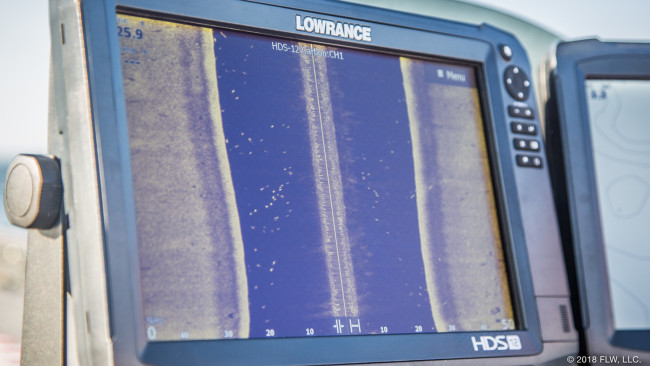
Of course, they could also be one of the species of carp collectively referred to as Asian carp that have infiltrated this and too many other river systems in the Midwest and South. Poor results in recent tournaments on Kentucky Lake and thousands of hours of angler observation all suggest that the 160,000-acre lake is in peril. Most of the blame has been placed on the carp.
While the biologists try to figure out a solution, anglers like Davis have started searching for new strategies for locating bass with fish-finding electronics in areas where carp are prevalent.
The “dots” that show up on StructureScan when the boat scans over carp look awfully similar to the dots that show up for bass. Interpreting how they’re situated on the ledge and how they react to boat pressure overhead are the keys to telling the difference, although sometimes the schools are so massive and spread so widely in the water column that they're obviously not comprised of bass.
Davis is still figuring it out, but he has a few tricks. After marking what he thinks are either white bass or largemouths, he flips 180 degrees and goes over them again, repeating the procedure a couple more times after that.
“That’s one way to tell if they’re carp,” he says. “If they move around, they’re probably carp.”
One final pass tells the tale.
“Nobody home,” he says.
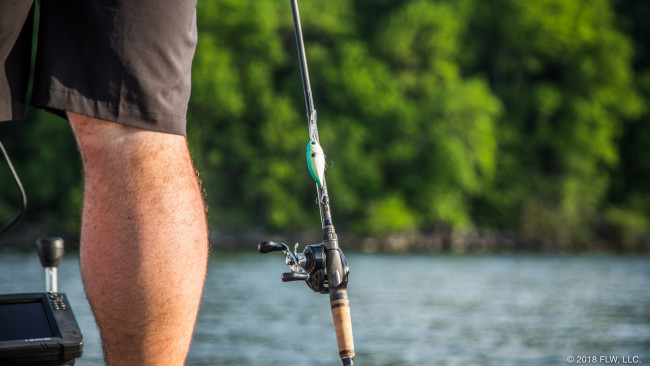

Though he has hundreds of waypoints on Kentucky Lake, Davis still enjoys the hunt for new spots. Finding something overlooked or untouched is a rewarding discovery. This morning, however, he’s simply running waypoints, checking community holes and generally being efficient with his time. He's taking the lake's temperature, so to speak.
Davis decides to make a few casts on a middepth drop in the mouth of a creek just to see what’s home and pulls out a deep-diving Yo-Zuri crankbait. He pitches it a short way just to verify it’s running straight, then starts firing.
“This place may be off, but it’s gonna happen,” he says, predicting we’ll see decent weights despite the pessimism frequenting the Kentucky Lake fishing community. “It may not be as good [as usual] though.”
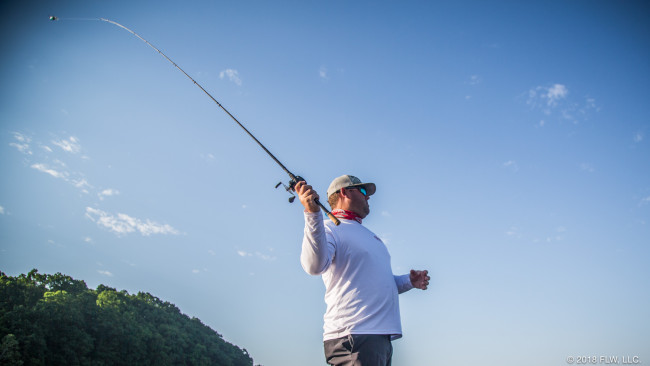
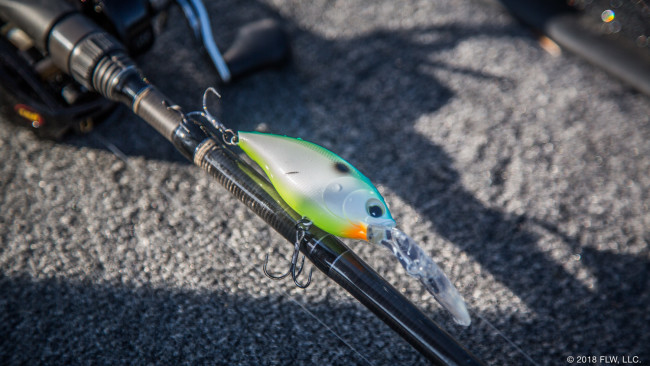
Davis makes a dozen or so casts with the crankbait and a 5-inch swimbait. He’s parked up on top of the structure, firing along and down the edge. It looks like strategic boat placement, but maybe not.
“I don’t even get caught up in bringing it out or bringing it up,” he says. “I just try to make a cast that brings it through as many fish as possible.”
He’s done that and seen enough already. If bass were here, he’d know it.
“All right, that’s enough,” he says before stowing the trolling motor and turning toward the back of the cut.

Rather than run down the main lake, Davis cracks open a bottle of water and idles farther in, scanning any kind of drop and even idling along the bank. He’s backtracking toward the beds and goes about halfway before stopping to give a wide berth to a local angler who’s running the bank in the back of the creek. There’s nothing here that excites him.
Then it’s on up the lake for Davis. His next few stops reveal massive schools of what he figures can only be carp. If anyone wants to know where to find them, Davis has their number.

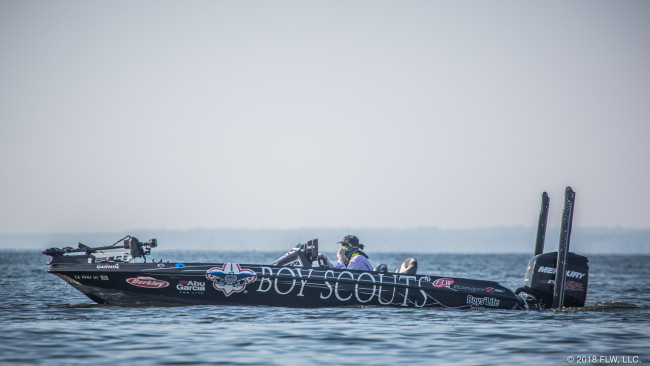
He stops on another well-known community hole and idles one end while Texas pro Tom Redington, who’s also a ledge stick, idles the other.
“Man, I’m gonna throw right here,” Davis says. “I don’t think those are bass, but maybe we can catch one on the community hole.”
No such luck. If bass are down there, they’re not cooperating.
“I think they’re white bass,” he says, with more of a questioning tone than one of confidence. “I just wanted to see if there was a bass mixed in here.”

The next waypoint is on another community hole. A few other boats, both locals and pros, are doing the zigzag on nearby drop-offs. This particular spot is deeper than the rest. The carp are there in big numbers, as is another feature Davis wishes he wasn’t seeing.
“Somebody’s put brush here. Brush ruins a deep hole for schools. You’ll get two or three off it, but no mega-schools.
“This looks like mega-carp.”
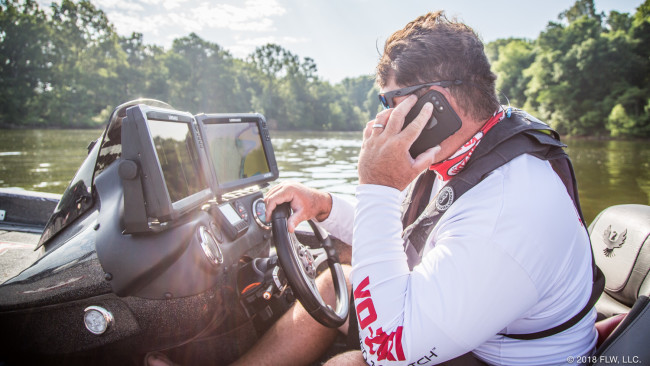
It’s 8:30 when Davis glides into a large creek on plane. He slows to idle when his phone rings, which kicks off a series of phone calls with fellow pros Braxton Setzer and Cody Meyer. Davis says he talks regularly with 10 or so pros, some more often than others. Their reports are the same: The fish aren’t up or out in numbers. They’re in transition. And the carp are everywhere.
After swapping a few more details on water temperature and areas searched, Davis hopscotches around to little pieces of structure. He’s waiting for another tournament boat to leave a particular drop-off that he’d really like to check. Eventually the other pro leaves, so Davis slides in, but there’s no one home.

Davis’ success and experience on Kentucky Lake reinforce that he’s a ledge expert. Since 2013, he has three top-10 finishes on the lake in Costa FLW Series competition, plus another top 10 in Tour competition, all in the peak ledge months of May and June.
It seems like every other spot he visits prompts a recollection of a tournament day when he smashed them on that spot.
What’s remarkable is that most of them are obvious community holes. Davis' expertise obviously makes him more adept at capitalizing on a spot's potential than many of the rest of us.
The latest stop is at another well-known spot. Davis idles over some carp and what he thinks is a little cluster of bass, prompting a flip and a re-check. The first time, it looks good. The second time, just OK. And on the third pass, the fish are mostly gone.
“How ’bout that?” he asks. “That’s how you find out.”
But then, a couple more wider passes reveal a cluster of fish that stays put just on the edge.
“I’m kind of thinking these might be bass because they’re not moving,” he says.
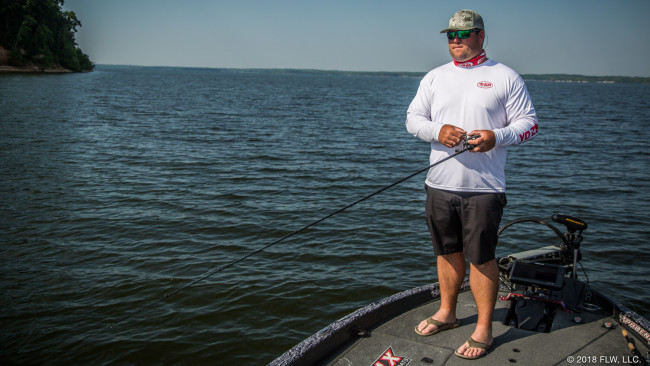
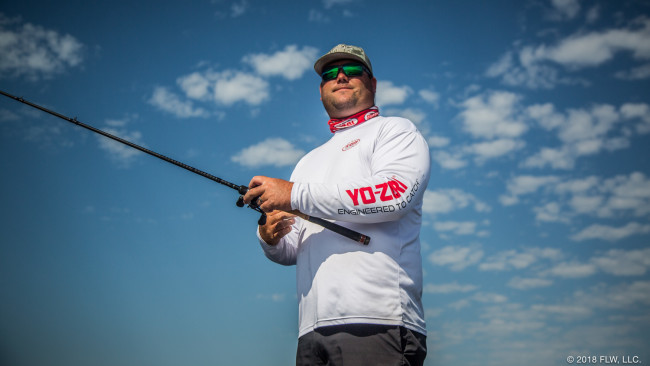
Davis slings a few casts their way without so much as a bump.
“I went from thinking they were bass to knowing they were carp. Definitely carp.”
A sudden jolt briefly changes his mind, but Davis realizes he probably just collided with one of the big invasives.
“Ooh. I don’t know if I hit him or he hit me, but I think I hit him. Now I’ve got to make one more cast.”


The next couple stops show more of the same: Lots of carp, and a few mystery fish here and there that could be the right species.
Davis adds a few waypoints and casts on one spot but seems anything but confident at this point.
He keeps a careful eye on the water temperature, too. It’s in the mid-70s. He’d like to see it warm just a few more degrees, which is quite likely to happen before the tournament if the practice forecast (lots of sun and warm weather) is accurate.

At a few minutes before 10, Davis starts cutting across the lake. His plan is to run waypoints up the west side back toward the launch ramp, where he can shed the eyes of the tagalong journalist and end the worry of revealing too much information to his competitors.
He marks another of those promising clusters of unidentified fish and stops to make a few casts. Nothing.
“That’s another thing that worries me. If you are fishing for little groups of them, and you pull up on 10 little groups of Asian carp by mistake, you can burn up a lot of your day really fast.”

It’s not long before Davis is running secondary structure up the west bank. He squeezes in a phone call with Randy Haynes, and the report is just as bleak – typical day one uncertainty.
A swing toward a small, shallow point reveals something of interest, however, and Davis pulls out his swimbait to make a cast.
“There are a couple of fish right there,” he says. “I’ve never been this close to a bank on Kentucky Lake other than at blastoff.”
He’s probably right. A minute later, John Cox rolls in and starts fishing within sight. If you’re that close to Cox, you’re not offshore.

Davis thoroughly works over the point, questioning himself out loud about whether or not it’s a waste of time. Then he gets the first bite of the day. Then the second. And the third, swinging this time and missing.
Something – an angry bluegill or a baby bass, perhaps – is thumping his swimbait but not getting the hook. It happens again and again. Davis tries a crankbait, but even treble hooks don’t connect.
“I might have to go fish more of these shallow bars,” he says. “I don’t know what they are. They can’t get it in their mouth apparently.”
It's not really a productive spot, but the bites, along with a strange green beetle that lands on the front deck, at least make it a more interesting stop than several of the previous places he's checked.
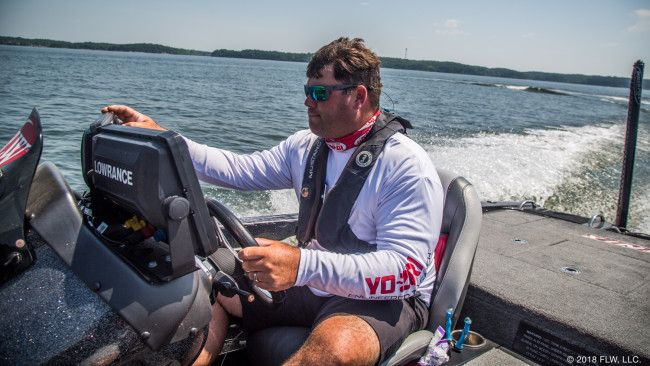
The next two stops are fruitless for Davis. He marks fewer carp, which is a small plus, and gets another update from Meyer, who’s actually fishing just a few hundred yards away.
So far, there’s nothing happening on the ledges of the north end to get Davis worked up, and he begins to formulate a new strategy. Instead of idling “out,” he’s considering idling some shallower structure and spending more time with a rod in his hand “just fishing" on places in between where he thinks they've been and where he hopes they're going.
I won’t get to see it, however. He’s within sight of the dam again, so Davis cruises back to the marina to drop me off.

On the idle in, Davis mixes up a batch of some sort of rejuvenating beverage. He’ll need it to get through what has already become a stifling, hot day.
He’s nervous about the situation, but it’s still way too early to be in any kind of panic mode. Davis still believes the fish are coming. Will it happen by Thursday, or will it be next week? That’s his biggest concern, because if they aren’t out by game time, he’ll have to resort to some other type of fishing other than ledge fishing, which is how he’d prefer to approach this tournament.
“I hope it gets better,” he says. “Otherwise, I’ll just be hoping to get paid by chunking and winding on the bank.”


Back at the dock, I jump out and head for lunch – BBQ probably. Davis, with much work still to do, digs out a sandwich and goes back to work. He’s got many more hours of prep time ahead of him and a puzzle that likely won’t be easy to solve.